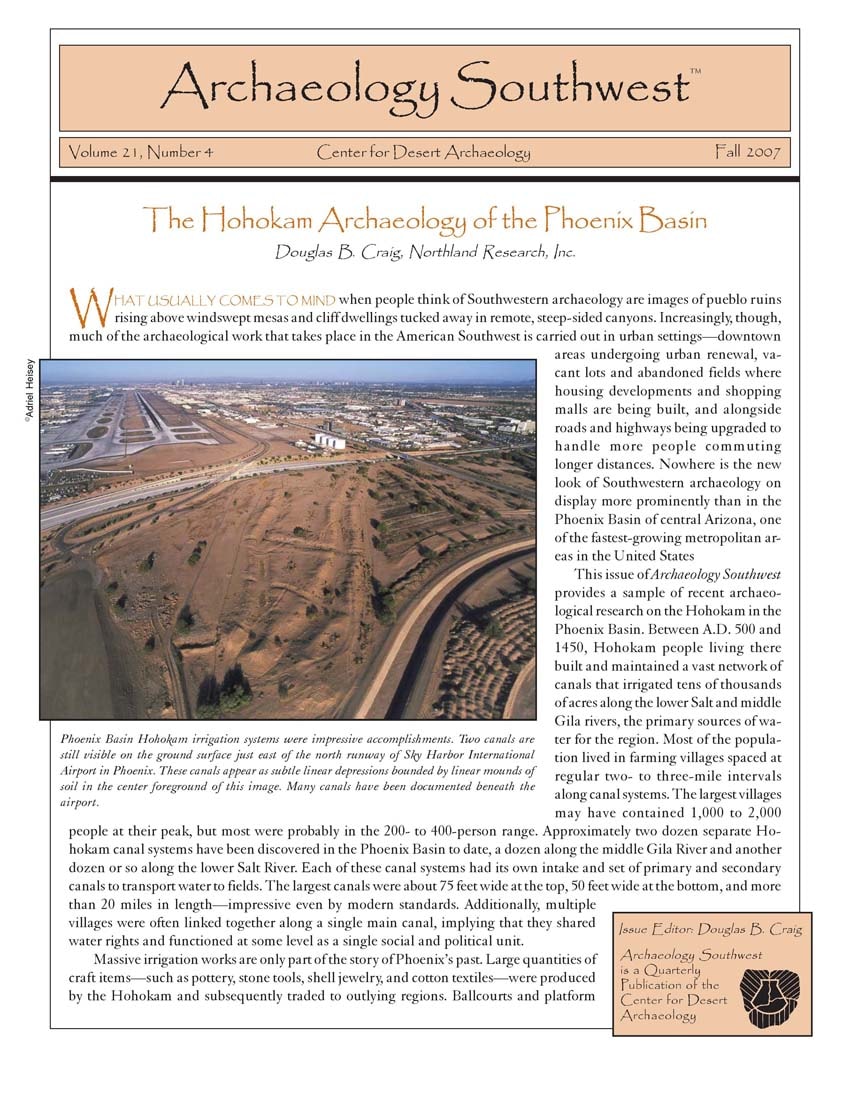The Hohokam Archaeology of the Phoenix Basin

Phoenix Basin Hohokam irrigation systems were impressive accomplishments. Two canals are still visible on the ground surface just east of the north runway of Sky Harbor International Airport in Phoenix. These canals appear as subtle linear depressions bounded by linear mounds of soil in the center foreground of this image. Many canals have been documented beneath the airport.
Archaeology Southwest Magazine Vol. 21, No. 4
FREE PDF DOWNLOAD
Issue editor: Douglas B. Craig, Northland Research, Inc.
This issue of Archaeology Southwest Magazine highlights recent research in Hohokam archaeology in the Phoenix Basin.
What usually comes to mind when people think of Southwestern archaeology are images of pueblo ruins rising above windswept mesas and cliff dwellings tucked away in remote, steep-sided canyons—yet much of the archaeological work that takes place in the American Southwest is carried out in urban settings as a result of urban renewal, residential and commercial development, and infrastructure improvements. The new look of Southwestern archaeology is especially evident in the Phoenix Basin of central Arizona, one of the fastest-growing metropolitan areas in the U.S.
This issue presents a sample of recent archaeological research on the Hohokam in the Phoenix Basin. Between A.D. 500 and 1450, the Hohokam built and maintained a vast network of irrigation canals along the lower Salt and middle Gila rivers. Most of the population lived in farming villages along these systems; at their peak, the largest villages may have held as many as 1,000 to 2,000 people. The articles proceed roughly chronologically, beginning with an overview of Pueblo Patricio, a site that provides evidence of increasing sedentism between A.D. 1 and 450; several pieces that examine developments in regional exchange, ceramic production, and residential stability in the subsequent pre-Classic period (A.D. 500–1100); continuing with discussions of the canal systems and their social and ecological implications; a report on the Southwest Germann site, which was occupied during the late pre-Classic and Classic periods (A.D. 1100–1450); an analysis of population collapse during the late Classic period; an article that reveals the importance of O’odham and Pee Posh beliefs and oral history for understanding trail systems; a description of the preservation-based methods and goals of the South Mountain Rock Art Project; and closing with an overview of long-term cycles of change in Tucson and Phoenix.
Articles include:
The Hohokam Archaeology of the Phoenix Basin — Douglas B. Craig, Northland Research, Inc.
Phoenix Rising: The Phoenix Convention Center — Mark Hackbarth, Logan Simpson Design, Inc.
The Ballcourt Village of Palo Verde Ruin — David R. Abbott, Arizona State University
Keys to Time — Henry D. Wallace, Desert Archaeology, Inc.
Household Persistence at the Grewe Site — Douglas B. Craig, Northland Research, Inc.
Exceptional Pithouses from the Gillespie Dam Site — T. Kathleen Henderson, Desert Archaeology, Inc.
Identifying Social Groups in Hohokam Irrigation Communities — Jerry Howard, Arizona Museum of Natural History
Of Canals and Water: Recent Analysis and Unusual Deposits — Michael S. Droz, Archaeological Consulting Services, Ltd.; Manuel R.Palacios-Fest, Statistical Research, Inc.; Glenn S. L. Stuart, Archaeological Consulting Services, Ltd.; and Allan Schilz, Archaeological Consulting Services, Ltd.
Building and Cleaning the Snaketown Canal — Kyle Woodson, Gila River Indian Community Cultural Resource Management Program and Arizona State University
The Southwest Germann Site — Banks L. Leonard, Soil Systems, Inc.
Hohokam Population Collapse in the Salt River Valley — J. Brett Hill, Center for Desert Archaeology and Hendrix College
Ancient Trails of the Arid Southwest — J. Andrew Darling and Barnaby V. Lewis, Gila River Indian Community
Rock Art and Landscape Archaeology in Arizona’s South Mountains — Aaron Wright, Center for Desert Archaeology and Washington State University; Steve Swanson, Arizona State University; and Todd Bostwick, City of Phoenix
Phoenix, Tucson, and the Cycles of History — William H. Doelle, Center for Desert Archaeology
Back Sight — William H. Doelle, Center for Desert Archaeology
Subscribe

